Topics to be Learn:
- Reproduction
- Asexual reproduction
- Sexual reproduction
- Microsporogenesis
- Structure of anatropous ovule
- Megasporogenesis
- Pollination
- Outbreeding devices — Contrivances
- Pollen pistil interaction
- Double fertilization
- Development of endosperm
- Development of embryo
- Seed and fruit development
- Apomixis
- Parthenocarpy
- Production of young ones like parents.
- Essential process for continuity of species.
- Offspring show similar characters to parents.
Types of Reproduction
Asexual reproduction:
- Does not involve fusion of two compatible gametes.
- Produces genetically identical progeny, i.e., clones.
- Progeny from single organism.
- Inheritance of genes of parent by progeny.
Modes of Asexual Reproduction
Fragmentation:
- Occurs in lower plants, e.g., algae.
- Multicellular organisms break into small pieces called fragments.
- Fragments develop into new plants.
- Reasons: accidental breakdown, death and decay of cells, etc.
Budding:
- Common in unicellular organism yeast.
- Occurs in favourable conditions.
- Mother cell produces small outgrowth known as bud.
- Buds may be one or more and grow as new individuals on separation.
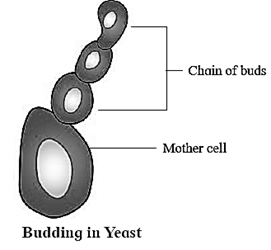
Spore formation:
- Common in lower plants.
- Occurs by production of motile zoospores.
- Zoospores grow independently into new individuals.
- Biflagellate zoospores formed in algae Chlamydomonas.

Fission:
- Binary Fission.
- Examples: Amoeba, Paramoecium.
Conidia formation:
- Example: Fungus Penicillium.
Gemmule formation:
- Example: Sponges.
Vegetative Reproduction
Definition:
- Plants reproduce asexually from their vegetative plant parts.
- New plants formed are genetically similar to parents.
Usefulness:
- Very useful in agriculture and horticulture.
- Artificial methods like cutting and grafting propagate desired varieties.
Artificial Methods of Vegetative Reproduction
Cutting:
- Small pieces of plant parts with one or more buds selected for propagation.
- Types:
- Stem cutting (e.g., Rose, Bougainvillea)
- Leaf cutting (e.g., Sansevieria)
- Root cutting (e.g., Blackberry).
Grafting:
- Joining of two plant parts: stock and scion.
- Stock: Rooted plant.
- Scion: Joined plant.
- Grow together as one plant.
- Types:
- Stem grafting (e.g., Apple)
- Bud grafting (e.g., Rose).
Tissue Culture:
- A small amount of plant tissue grown aseptically to get plantlets.
- Micropropagation: Modern method for plants from tissue culture (e.g., Orchids).
Sexual Reproduction
Definition:
- Involves fusion of two compatible gametes.
- Results in production of genetically dissimilar offspring.
Variations:
- Set in, important for survival and evolution of species.
- Occurs after certain maturity.
- Higher plants: Flowering indicates beginning of reproductive phase.
Flowers
- Definition:
- Specialized reproductive structure producing haploid gametes.
- Ensures fertilization.
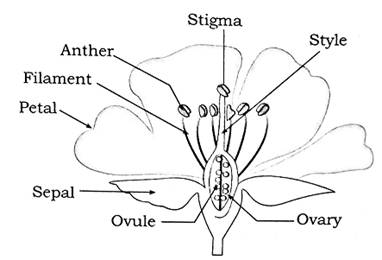
Accessory Whorls:
- Calyx: Sepals.
- Corolla: Petals.
Essential Whorls:
- Androecium (Stamen): Filament, Connective, Anther lobe: Pollen grains.
- Gynoecium (Pistil): Style, Stigma, Ovary: Ovule.
Sexual Reproduction - Two Major Events
Meiosis:
- Production of gametes (n).
- Male gametes: In anther.
- Female gametes: In ovule.
Fusion of Gametes (Fertilization):
- Diploid zygote -> Embryo -> New plant (2n) sporophyte.
Dominant Plant Body:
Diploid sporophyte.
Meiosis -> Haploid spores -> Gametophyte -> Reduced structure -> Within flower -> Gametes.Structure of Anther - Mature Anther
- Immature Stage:
- Group of parenchymatous tissue surrounded by single-layered epidermis.
- Usually dithecous (having two lobes) -> tetrasporangiate (four pollen sacs).
- Monothecous (single lobe) -> Bisporangiate (two pollen sacs).
- Young: Homogeneous.
- Parenchymatous with epidermis.
- Heterogeneity appears with formation of archesporial cell.
Transverse Section of Anther (T.S. of Anther)
- Internal Structure: Four chambers called microsporangia or pollen sacs.
Layers of Anther Wall
Epidermis:
Outermost layer, Made up of flattened cells for protection.Endothecium:
- Lies internal to epidermis.
- Single layer of cells.
- Fibrous thickenings on radial walls.
Middle Layers:
- 1 to 3 layers of parenchymatous cells.
- Degenerate during microspore formation.
Tapetum:
- Innermost nutritive layer.
- Single layer of cells surrounding sporogenous tissue.
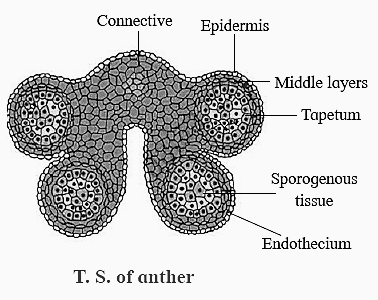
Microsporangium Content
- Contains microspore mother cells (2n).
- Undergo meiosis to form microspore tetrad (n).
- Microspores separate from tetrad.
- Development of wall around microspores -> pollen grain.
- From archesporial cell:
- Primary parietal cell forms anther wall.
- Sporogenous cell forms sporogenous tissue
Microsporogenesis
- Definition:
- Formation of Microspores by meiosis from MMC (Microspore Mother Cell).
- Each MMC divides meiotically to form tetrad of haploid microspores (pollen grains).
Pollen Grain
- Non-motile with single nucleus, Haploid.
- Pollen wall, double-layered - Sporoderm.
Structure of Microspore
- Typical pollen grain: Non-motile, haploid, unicellular body with single nucleus.
- Surrounded by two-layered wall called sporoderm.
Exine (Outer Layer):
- Thick, Made up of complex, non-biodegradable substance called sporopollenin.
- Smooth or with sculptured pattern.
- Resistant to chemicals.
- Thin areas known as germ-pores for pollen tube growth during germination.
Intine (Inner Wall Layer): Consists of cellulose and pectin, Forms pollen tube smooth.
Pollen Viability
- Functional ability of pollen grain to form male gametophyte by germination.
- Factors Affecting Germination: Temperature and humidity.
- Duration of Viability:
- Low up to 30 minutes in rice and wheat.
- Up to months in some plants of families Leguminosae, Rosaceae, and Solanaceae.
Development of Male Gametophyte

- First Mitotic Division: Two unequal cells: (i) Vegetative cell, (ii) Generative cell.
- Second Mitotic Division:In generative cell -> equal cells.
- Process:
- Pollen grain is first cell of male gametophyte.
- Protoplast of pollen grain divides mitotically to form two unequal cells:
- Small thin-walled generative cell.
- Large naked vegetative or tube cell.
- Generative cell separates and floats in cytoplasm of vegetative cell.
- Vegetative cell possesses thick cytoplasm, irregular-shaped nucleus, and reserved food.
- In most angiosperms, pollen grains are liberated at two-celled stage after anther dehiscence.
- Generative cell divides by mitosis to form two male non-motile gametes, either in pollen grain or in pollen tube.
- Pollen grains shed in either two- or three-celled stage, lodged on stigma of pistil.
Structure of Anatropous Ovule (Most Common Type)
Definition:
Ovule with bent axis and downwardly directed micropyle.Common Type:
Most common type of ovule in angiosperms.
Parts of Anatropous Ovule
Funiculus:
Stalk of the ovule attaching it to placenta.Hilum:
Point of attachment of funiculus to ovule body.Nucellus:
Made up of diploid parenchymatous cells.Integuments:
- Protective coverings of nucellus.
- Outer and inner layers.
Micropyle:
- Narrow opening at apex.
- Integuments do not completely cover nucellus, leaving a small opening.
Chalaza:
Basal part of nucellus.Female Gametophyte or Embryo Sac:
- Oval-shaped structure towards micropylar end.
- Embedded in nucellus.
- Oval, elongated, multicellular seven-celled structure.
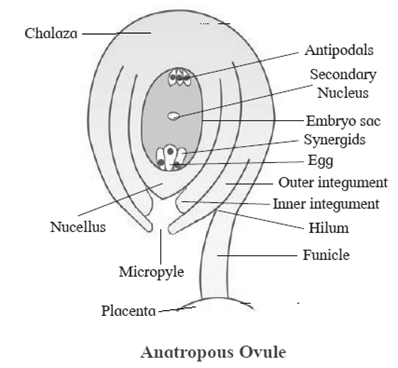
Presence of Ovules
Uniovulate:
Examples: Mango, Wheat, Rice.Multiovulate:
Examples: Tomato, Lady's finger.
Megasporogenesis
- Definition: Process where diploid megaspore mother cell undergoes meiosis to form a tetrad of haploid megaspores.
Development of Female Gametophyte
Formation of Megaspores:
- Megaspore mother cell undergoes meiosis forming linear tetrad of four haploid megaspores.
- Chalazal Megaspore: Generally becomes functional megaspore, others degenerate.
Chalazal Megaspore:
- First cell of female gametophyte.
- Enlarges and develops into female gametophyte.
Mitotic Divisions:
- Diploid nucellus of chalazal megaspore undergoes three successive free nuclear mitotic divisions.
- First mitotic division forms two nuclei.
- Both nuclei undergo two successive mitotic divisions forming four nuclei at poles.
Formation of Secondary Nucleus:
- One nucleus from each pole moves towards centre, fuses to form diploid nucleus, secondary nucleus.
Organization of Nuclei:
- Three nuclei at micropylar end form three-celled egg apparatus.
- Three nuclei at chalazal end form three antipodal cells.
- Egg Apparatus:
- Central cell: Egg cell or female gamete.
- Flanked by two lateral cells: Synergids.
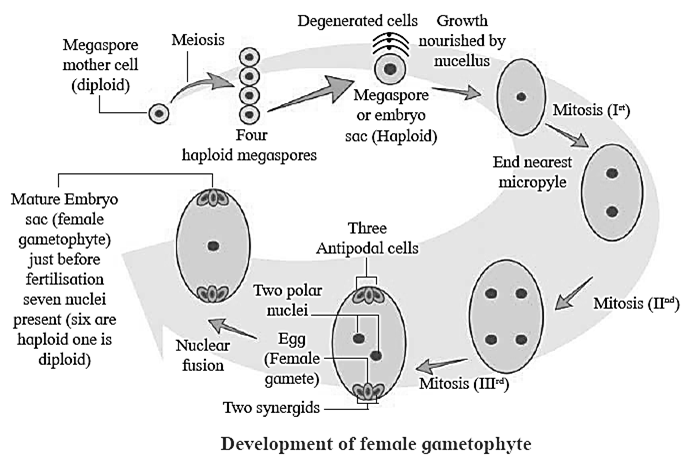
Composition of Female Gametophyte
- Egg apparatus, secondary nucleus, and three antipodal cells.
- Seven-celled, eight-nucleated structure.
Pollination
- Pollination: Transfer of pollen grains from anther to stigma.
Types of Pollination
1. Self-pollination:
- Pollen from anther to stigma of same/different flower with same genetic makeup.
- Occurs in single or two flowers of same plant.
- Autogamy: Bisexual flower pollinated by its own pollen.
- Offspring genetically identical to parents (e.g., Pea).
2. Cross-pollination (Outbreeding):
- Pollen from anther of one flower to stigma of another flower with different genetic makeup.
- Xenogamy: Involves two different plants.
- Requires pollinating agent.
- Genetically varied offspring (e.g., food and fibre crops).
Types of Cross Pollination
(a) Chasmogamy: Flowers open and expose sex organs.(b) Homogamy: Anther and stigma mature simultaneously.
(c) Cleistogamy: Flowers remain closed (e.g., Viola, Commelina).
(d) Geitonogamy: Transfer of pollen grains to stigma of other flower produced on same plant (e.g., unisexual flowers of Cucurbita).
Agents of Pollination
(1) Abiotic (Non-living)
Wind (Anemophily)
- Transfer of pollen grains through wind.
- Anemophilous plants:
- Small, inconspicuous flowers.
- No bright colors, fragrance, or nectar.
- Flowers produced in large numbers.
- Stamens are long with versatile anthers.
- Feathery stigma exposed to receive pollen grains.
- e.g., Grasses, maize, Jowar, Palms.
Water (Hydrophily)
- Transfer of pollen grains with the help of water.
- Hydrophilous plants:
- Small, inconspicuous unisexual flowers.
- Lack fragrance, nectar, and bright colors.
- Pollen grains and floral parts protected from getting wet.
- Long, sticky stigma.
- e.g., Zostera, Vallisneria.
(2) Biotic (Living)
Insects (Entomophily)
- Pollination with the help of insects.
- Entomophilous flowers:
- Large and attractive.
- Brightly colored with pleasant smell.
- Produce nectar.
- Spiny and sticky pollen grains.
- e.g., Rose, Jasmine, Cestrum, Salvia.
Birds (Ornithophily)
- Pollination through birds.
- Ornithophilous plants:
- Large and showy flowers.
- Brightly colored, lack fragrance.
- Sticky and spiny pollen grains.
- e.g., Callistemon, Bignonia, Bombax, Butea.
Bats (Chiropterophily)
- Pollination with the help of bats.
- Chiropterous flowers:
- Large and stout.
- Nocturnal, emit fruity odors.
- Produce copious nectar and edible pollen grains.
- e.g., Anthocephalus, Kigellia, Adansonia.
Outbreeding Devices - Contrivances
- Mechanisms to prevent self-pollination and promote cross-pollination.
- Self-pollination leads to inbreeding depression; cross-pollination is needed.
- Observed in plants.
Devices Observed in Plants
Unisexuality
- Plants bear either male or female flowers.
- Avoids self-pollination.
- Plants are either dioecious (e.g., Maize) or monoecious (e.g., Papaya, Mulberry).
Dichogamy
- Stamens and carpels mature at different times in a bisexual flower.
- Avoids self-pollination and favors cross-pollination.
- Protandry: Anthers mature before stigma (e.g., Sunflower).
- Protogyny: Stigma matures before anthers (e.g., Gloriosa).
Prepotency
- Rapid pollen germination on other stigma of the same type (e.g., Apple).
Heteromorphy
- Different types of flowers in the same plant.
- Stigmas and anthers at different levels.
- Types: Heterostyly, Heteroanthy
- Prevents self-pollination (e.g., Primrose).
Herkogamy
- Mechanical device in bisexual flowers to prevent self-pollination.
- Natural physical barrier between sex organs.
- Prevents contact of pollen with stigma (e.g., Calotropis).
Self-Sterility
- Genetic mechanism preventing pollen germination on the same flower's stigma.
- E.g., Tobacco, Thea.
Pollen-Pistil Interaction
- Self-Incompatibility
- Genetic mechanism preventing pollen germination on the same flower's stigma.
- Favors cross-pollination (e.g., Tobacco).
- Pollen-Pistil Interaction
- Pistil recognizes and allows germination of compatible pollen.
- Special proteins on stigmatic surface determine compatibility.
- Physiological Mechanism:
- Compatible pollen absorbs water and nutrients from stigma.
- Pollen tube emerges, grows through style to ovule.
- Tip enters synergid.
- Growth determined by specific chemicals.
- In vitro Tube Growth: Pollen grains induced to grow on artificial medium (sucrose, boric acid).
Artificial Hybridization
- Approach in Crop Improvement : Major approach in plant breeding programs.
- Procedure
- Only desired pollen grains are hand-pollinated.
- Emasculation: Removal of anthers before flower opening.
- Bagging: Protecting emasculated flowers.
Double Fertilization
- Definition: Fertilization where both male gametes participate in the complex mechanism seen in angiosperms.
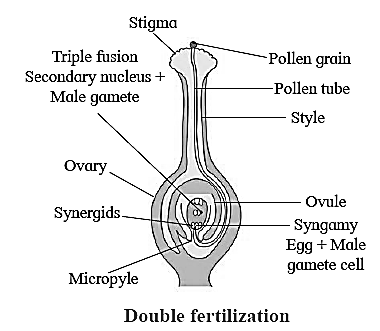
Importance of Double Fertilization
- Ensures seed formation with food storage for embryo.
- Diploid zygote develops into embryo, forming a new plant.
- Triploid PEN forms endosperm, nutritive tissue for embryo.
- Restoration of diploid condition by syngamy.
Characteristic Features of Angiosperms
- Porogamy: Pollen tube entering ovule through micropyle.
- Most common type: Enters synergid and releases content (2 non-motile male gametes).
- Chalazogamy: Entry of pollen tube through chalaza.
- Mesogamy: Entry of pollen tube through integuments.
- Siphonogamy: Non-motile gametes present in pollen tube.
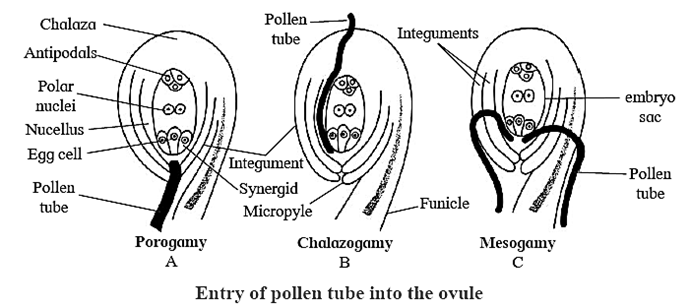
Process of Double Fertilization
- Two male gametes participate in fertilization.
- Steps:
- Pollen tube enters embryo sac through micropyle, bursts in synergid.
- Two male gametes released.
- One unites with egg, other with secondary nucleus.
- Formation of triploid primary endosperm nucleus (PEN).
- Fusion with egg nucleus forms diploid zygote (syngamy).
- Reproductive process: Non-motile male nuclei carried to egg cell through pollen tube (siphonogamy).
- Zygote develops into embryo, ovule changes leading to seed development.
Process of Double Fertilization in Embryo Sac
(1) Syngamy (Generative Fertilization)
- 1 male gamete unites with egg cell.
- (n) + (n) = 2n -> Zygote (2n) -> Embryo.
(2) Triple Fusion (Vegetative Fertilization)
- Out of two male gametes, first fuses with egg, second with secondary nucleus.
- Called triple fusion or second fertilization.
- First fusion: Male gamete + Egg -> Zygote (2n).
- Second fusion: Male gamete + Secondary nucleus -> PEN (3n) -> Endosperm (Nutritive tissue).
Significance of Double Fertilization
- Unique feature of angiosperms.
- Concerned with seed production.
- Zygote develops into embryo, forming new plant.
- Triploid PEN forms endosperm, nutritive tissue.
- Restoration of diploid chromosome number.
- Avoids polyembryony.
Development of Endosperm
- Nutritive tissue nourishing embryo.
- Develops from PEN.
- Post-fertilization tissue.
- Types: Endospermic (e.g., Castor, Maize) and Non-endospermic (e.g., Bean, Pea).
Types of Endosperm

Nuclear Endosperm
- Most common type.
- Formation:
- Primary Endosperm Nucleus (PEN) undergoes free nuclear division.
- Triploid nuclei remain suspended in central cell cytoplasm.
- Nuclei pushed towards periphery by central vacuole.
- Wall formation around nuclei to form cellular mass.
- Seen in plants like maize, sunflower, wheat, coconut.
Cellular Endosperm
- Formation:
- PEN undergoes nuclear divisions followed by cytokinesis.
- Endosperm develops in cellular form.
- Less common, seen in dicots like Datura, Petunia, Balsam, Adoxa.
- Formation:
Helobial Endosperm
- Formation:
- First division of PEN followed by cell wall formation.
- Central cell divided into large micropylar cell and small chalazal cell.
- Further development in both chambers:
- Micropylar chamber: Nuclear type, walls develop between nuclei.
- Chalazal chamber: Nuclear type.
- Seen in plants of order Helobiales of Monocots, e.g., Asphodelus.
- Formation:
Mosaic Endosperm
- Endosperm containing tissues of two different types.
- Seen in plants like corn, where endosperm contains patches of two different colors, forming a mosaic pattern.
Development of Embryo
- Embryogenesis: Development of zygote into embryo.
- Zygotic embryo situated towards micropylar end in embryo sac.
- Growth of embryo begins when some amount of endosperm is formed.
- Zygote develops wall, becomes oospore.
2-Celled Pro-Embryo

- Formation:
- Oospore divides transversely.
- Large basal cell towards micropyle, small apical cell towards chalaza.
- Basal cell forms multicellular suspensor.
- Suspensor draws nutrition from endosperm.
- Apical cell divides transversely, then vertically to form 8-celled octant stage.
- Lower four cells become hypocotyl and radicle, upper four form plumule and cotyledons.
- Hypophysis forms part of radicle and root cap.
- Upper cells divide to form heart-shaped embryo, elongating into two cotyledons.
- Enlargement results in curved, horseshoe-shaped embryo.
Embryogenesis in Monocots
- Similar till octant stage.
- Single cotyledon.
- Scutellum: Shield-shaped cotyledon.
- Coleorhiza: Protective covering of radicle.
- Coleoptile: Protective covering of plumule.
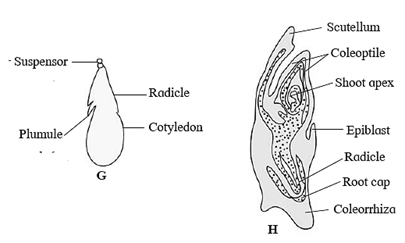
Seed and Fruit Development
Goal of Reproduction: Create offspring for next generation.
Seed Formation: Initiated by fertilization.
Seed Coat Development:
- Integuments: Form seed coat.
- Testa: Outer integument.
- Tegmen: Inner integument.
- Integuments: Form seed coat.
Perisperm: Remnants of nucellus in seed.
- e.g., Black pepper, beet.
Pericarp: Ovary wall becomes fruit wall.

Types of Seeds
Endospermic or Albuminous:
- e.g., Castor, Maize.
Non-Endospermic or Exalbuminous:
- e.g., Bean, Pea.
Cotyledons: Store food materials.
Micropyle: Opening in seed coat for emergence of radicle.
Significance of Seed and Fruit Formation
- Nourishment: Provides nourishment to seed inside fruit.
- Protection: Protects seed.
- Propagating Unit: Helps in reproduction.
- Dispersal: Aids in spread of species.
Seed Dormancy
- Definition: Metabolic arrest for survival in unfavorable conditions.
- Adaptive Measures: Structure or physiological adaptations.
- Dispersal: Seeds dispersed during dormancy.
- Germination: Occurs only after dormancy period is completed.
Apomixis
- Definition: Formation of embryo(s) through asexual reproduction without gamete formation.
- Results in rapid production of genetically identical plants.
Types of Apomixis
Apogamy:
Gametophytic cell produces embryo without fertilization.Apospory:
Sporophytic cell produces embryo without fertilization.Agamospermy:
Seed produced but embryo forms without meiosis and syngamy.
Categories of Apomixis
Recurrent Apomixis:
- Diploid sporophytic cell, archesporial cell, or nucellus form embryos.
- Diploid megaspore mother cell forms embryo sac (diplospory or apospory).
Non-recurrent Apomixis:
- Haploid embryo sac formed, embryos arise from egg cell or other haploid cell (apogamy).
Adventive Embryony:
- Additional embryos develop from nucellus or integuments.
- Results in polyembryony.
Parthenocarpy
- Definition: Fruit developed without fertilization.
- Natural Occurrence:
- Observed in Pineapple and Banana.
- Auxin (IAA) stimulus from placental tissues of unfertilized ovary.
- Enlargement of ovary forms fruit.
- Characteristics:
- Parthenocarpic fruits are seedless.
- e.g., Banana, Pineapple, Papaya.
- Artificial Induction:
- Gibberellins or physical methods.
- e.g., Grapes.
Polyembryony
- Definition: Development of more than one embryos inside seed.
- Types:
- Adventive Polyembryony:
- Embryos from diploid cells of nucellus or integuments.
- Cleavage Polyembryony:
- Zygote divides into small units, developing into embryos.
- Adventive Polyembryony:
- Advantages:
- Genetically uniform seedlings.
- Emergence of multiple seedlings.
- Beneficial in horticulture.
To know
- Fibrous Endothecium: Helps in anther dehiscence.
- Zoophily: Pollination by animals.
- Malacophily: Pollination by snails and slugs.
- Pollenkitt: Substance in insect-pollinated pollen grains from tapetum.
- Raphe: Part of funiculus united with ovule wall.
- Aleurone Layer: Outer part of starchy endosperm in maize grain, stores proteins.


0 Comments